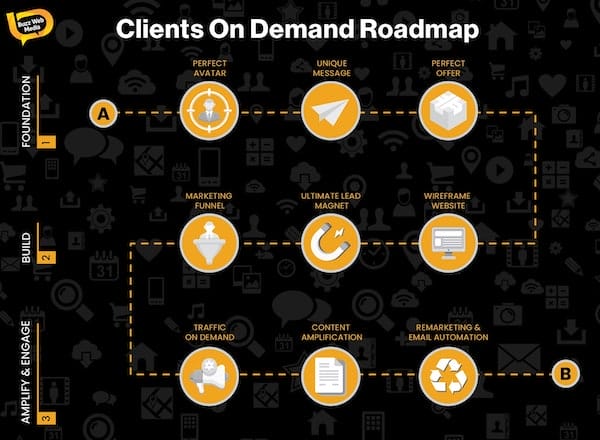If you’re a service based business and your website generates very few enquiries, then maybe you’re making some of these excuses:
- I need a new website (okay, maybe).
- People that buy my service research options before they buy.
- My service is a high ticket item, so I should expect lower conversions.
There may be some truth in these statements, but if you are spending time and money to get people to your website, are you happy with the getting business by accident approach?
When you’re growing your business you need a reliable system to attract and convert new leads…without that how can you be confident enough in your projected cashflow to invest in your business, to buy new equipment, to employ more staff?
Maybe you won’t triple your business, but the answer is in understanding what people are looking for, and having a system for converting (even if it is not to a sale) and systemising the follow up….good ecommerce businesses do this perfectly.
What ecommerce business do well that service based businesses should model from
If you make all of your money through online transactions you need to have everything down tight.
How do you increase conversions?
How do you engage and get people to come back and complete a purchase?
Well we’ve all been “victims” of an e-commerce site…
You look at a product, and all of a sudden you’re seeing ads for the same or similar items all over the place.
Add a product to the cart or start a checkout and not complete it, and they’re all over you!
These guys know that they’re competing against both their competitors and the short attention spans of their website visitors, so they’ve optimised their process for conversions (if not a sale then for your contact details) and for the follow up through retargeting and email. They’re not afraid to give themselves every chance to make a sale.
….but as soon as you’re a service based business you don’t want to offend people? You’re afraid they might see you in person and think you’re that business that pesters people.
Well maybe you could come off that way, but if you do it properly, targeting the right crowd with the right content then the people you really care about will be more likely to take action.
And those ones that whinge about you? Forget them….they never would have bought from you. They’re the ones that will umm and ahh and compare you against everyone else.
So what are the things you should be modelling?
1. Turn your service into a product
Well this is not so much something you will model, but think about how people look at a product. They can see it, they can touch and feel it…it’s something tangible where they know exactly what they are getting and what it will do.
When you’re offering a service, there are varying degrees of intangibility and “How long is a piece of string?” comes in. Every situation that you deal with may have variables that will impact the amount of time to complete and the outcome, but trust is a huge factor in making a sale so variables mean uncertainty, resulting in a drop in trust.
So the best thing you can do is look for opportunities to productise your service, to make it more tangible….to show that success is tied to a definable system.
Take a car service, for instance. They promote the cost of a minor or major service and what is included…this is something tangible we can grasp even if we don’t know exactly the value of changing an air filter. Of course, other issues may be identified in the course of completing a service but we know there is a fixed price up front and we have the choice of saying yes, or no, to having any other issues fixed.
Then you get onto expertise based businesses like business coaches and consultants. If this is you, you’re a subject matter expert and while you know a lot more than your clients, the desire to tell them everything you can do for them often times leaves them confused. And if you confuse, you lose.
As an expertise based business the best thing you can do is identify who your ideal client is and produce a roadmap for success that takes them from where they are now to where they want to be. Your roadmap, and your process for success then becomes your product. You know there are going to be variables, as there always are, but you’ve given the client something concrete to hold onto…they know they don’t grasp everything you do, but you’ve given them a process and a successful outcome they can picture.
As an example here is the roadmap we use for expertise based businesses to go from the grind of prospecting, doing “coffee-catchups”, sending proposals and then chasing people that just end up being tyre-kickers, to having an automated system that attracts, pre-qualifies and books sales meetings with ideal client prospects.

With this visual we can explain the steps, and the importance of each in reaching the outcome our own ideal clients are looking for, while giving comfort that there is a defined system for success.
2. Micro conversions – don’t make it all or nothing
You won’t always get an enquiry or close a sale from the first website visit, so the trick is to understand that and have a process in place to make sure you get something from them, e.g. their email address, and even name and phone number.
The options here include:
- Providing a free resource of value that people need to enter their email to receive
- A multi stage quote form that collects details
- An exit intent popup with some kind of offer, e.g. get 10% off
This does not include “Signup to our newsletter.” No one signs up for these any more….we get so many emails these days that you need to earn the right to get into peoples’ inboxes.
3. The Follow Up
Only a few years ago, we were limited to email for the followup (at least in the online medium), but recent years has made retargeting (or remarketing depending on the platform you are using) a whole lot easier for more businesses.
This means that you can continue to market to your website visitors, even if they did not leave their email address.
Travel and ecommerce websites do retargeting/remarketing well. You know as soon as you start researching a holiday, or looking at the cost of flights, if you do not complete a transaction they’re going to start displaying ads to you around the web…and the ads are relevant.
The advertising platforms allow you to be very sophisticated with your retargeting, and you can target based on actions people perform, or don’t perform on your website (and even actions taken in email). For example, you can target someone that visited a landing page but did not visit your thank you page, or even based on how much of a video they watched on your website.
So take the time to map out the actions you want people to take on your website, and what marketing communication that then prompts, from ads through to emails.
And make sure you communicate early, and often. If people have shared their email, or expressed interest in some other way, this is the point they are most interested in what you have to say or offer. If you have shared a valuable resource go deeper into that resource and how it fits into a bigger picture in a series of emails over the next few days…if you are offering valuable insights to a targeted audience they are not going to think it spammy if you share your expertise – as long as you let the value you offer be the promotion, not a self-serving pitch.
4. Reviews and referred trust
Social proof is huge now. People want to know if something works before they purchase, so the people and businesses you have worked with, and what they have to say about you, matter. You can say whatever you want about yourself, but credibility comes through third party endorsements.
If someone else has achieved a successful outcome through using your services, then people are more likely to believe you can do the same for them.
For every client that works with you, put in place a system to gather feedback. If it’s bad then that’s an opportunity for you to improve, but if it’s good then obviously ask them to share a review of your service, and give them a link to where you would like it shared, e.g. Facebook, Google, LinkedIn…wherever the people you are targeting are most likely to see it.
5. Be specific with your call-to-action
What do you want people to do? People don’t want to guess what the next action is that they need to take is, so make your call-to-action clear and readily available.
It might not be as universal as “Add To Cart” or “Checkout”, but let people know what the next step is and how to get started. Note that the inclination for most businesses will be to go straight for the sale, but there may be situations where you would rather collect details first and let your marketing close them later.
So I could have a call to action section like:
Stop Meeting with Tyre-Kickers and Sending Proposals that Will Never Turn Into Business
Or it could be as simple as buttons with:
Book a Service Call Today
Request Your Free Quote
So how does this all look when it comes together?
Here’s a great example I came across after receiving an enquiry for a website build from a cleaning company, and they shared this website as an example of one of the websites they like. He was only looking at the aesthetics of the website (and yes, that is important), but there are a number of other things they have done really well.
The lesson here is that you don’t need to reinvent the wheel. Whether in your industry, or in other industries, businesses are achieving success in their online marketing, so all you need to do is look at what they are doing well and model it.
Maybe you don’t know the technical aspects of how to implement something, but the good news is you can always find someone to do that for you…the best use of your time is keeping big picture and looking for new ways to innovate and grow your business.




